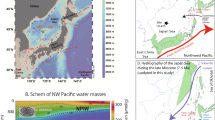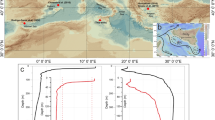Abstract
The high-resolution quantitative analysis of the planktonic foraminifera and the δ18O records of the section between 96.49– 137.6 mcd at ODP Site 1144 on the continental slope of northern South China Sea reveals an abrupt cooling event of sea surface temperature (SST) during the last interglacial (MIS 5.5, i.e. 5e). The dropping range of the winter SST may come to 7.5°C corresponding to 1.2‰ of the δ18O value of sea surface water. This event is comparable with those discovered in the west Europe and the northern Atlantic Ocean, but expressed in a more intensive way. It is inferred that this event may have been induced by middle- to low-latitude processes rather than by polar ice sheet change. Since the Kuroshio-index speciesPulleniatina obliquiloculata displayed the most distinct change at the event, it may also be related to the paleoceanographic change of the low-latitude area in the western Pacific Ocean. This event can be considered as one of “Younger Dryas-style coolings” and is indicative of climate variability of the last interglacial stage.
Similar content being viewed by others
References
Grootes, P. M., Stulver, M., Johnson, J. W. C. et al., Comparison of oxygen isotope records from GISP2 and GRIP Greenland ice cores, Nature, 1993, 366: 552–554.
Maslin, M., Sarnthein, M., Knaack, J. J. et al., Intra-interglacial cold events: An Eemian-Holocene comparison, The Geological Society of London, Special Publications, 1998, 131: 91–99.
Wang, P., Prell, W., Blum, P. et al., Proceedings of the Ocean Drilling Program, Initial Reports, 2000, 184.
Thompson, P. R., Bé A. W. H., Disappearrence of pink-pigmentedGlobigerinoides ruber at 120,000yr BP in the Indian and Pacific Oceans, Nature, 1976, 280: 554–558.
Martinson, D. G., Piasias, N. G., Hays, J. D. et al., Age dating and the orbital theory of the ice ages: Development of a high-resolution 0 to 300000-year chronostratigraphy, Quaternary Research, 1987, 27: 1–29.
Thompson, P. R., Planktonic foraminifera in the West North Pacific during the past 150,000 years: Comparison of modern and fossil assemblages, Palaeogeogr. Palaeoclimatol. Palaeoecol., 1981, 35: 241–279.
Tu, X., Zheng, F., Chen, M. et al., Planktonic foraminifera in continental slope of southern South China Sea and their implications to paleotemperature of surface sea water, Tropic Oceanology (in Chinese with English abstract), 2000, 19(3): 40–49.
Wang, L., Sarnthein, M., Erlenkeuser, H. et al., East Asian monsoon climate during the late Pleistocene: High-resolution sediment records from the South China Sea, Marine Geology, 1999, 156: 245–284.
Eglintin, G., Bradshaw, S. A., Rosell, A. et al., Molecular record of secular sea surface temperature changes on 100-year timescales for glacial terminations I, II, and IV, Nature, 1992, 356: 423–426.
Maslin, M., Sarnthein, M., Knaack, J.-J., Subtropical Eastern Atlantic climate during the Eamian, Naturwissenschaften, 1996, 83: 122–126.
Sarnthein, M., Tiedemann, R., Younger Dryas-style cooling events at glacial terminations I-VI at ODP Site 658: Associated benthic δ13C anomalies constrain meltwater hypothesis, Paleoceanography, 1990, 5(6): 1041–1055.
Thouveny, N., de Besulien, J.-L., Bonifay, E. et al., Climate variations in Europe over the past 140 kyr deduced from rock magnetism, Nature, 1994, 371: 503–506.
Li, B., Jian, Z., Wang, P. et al.,Pulleniatina obliquiloculata as a paleoceanographic indicator in the South Okinawa Trough during the last 20000 years, Marine Micropaleontology, 1997, 32: 59–69.
Wang, J., Saito, Y., Oba, T. et al., High-resolution records of thermocline in the Okinawa Trough since about 10000 aBP, Science in China, Ser. D, 2001, 44(3): 193–200.
Wang, P., Bian Y., Li, B. et al., “The Younger Dryas” in the west pacific marginal seas, Science in China, Ser. D, 1996, 39(4): 522–532.
Jian, Z., Chen, M., Lin, H. et al., Stepwise Paleo-ocanographic change of the last deglaciation in the southern South China Sea: Records of stable isotope and microfossils isotope and microfossils, Science in China, Ser. D, 1998, 41(2): 187–194.
Author information
Authors and Affiliations
Corresponding author
Rights and permissions
About this article
Cite this article
Tu, X., Zheng, F., Wang, J. et al. An abrupt cooling event early in the last interglacial in the northern South China Sea. Sci. China Ser. D-Earth Sci. 44, 865–870 (2001). https://doi.org/10.1007/BF02907077
Received:
Issue Date:
DOI: https://doi.org/10.1007/BF02907077




